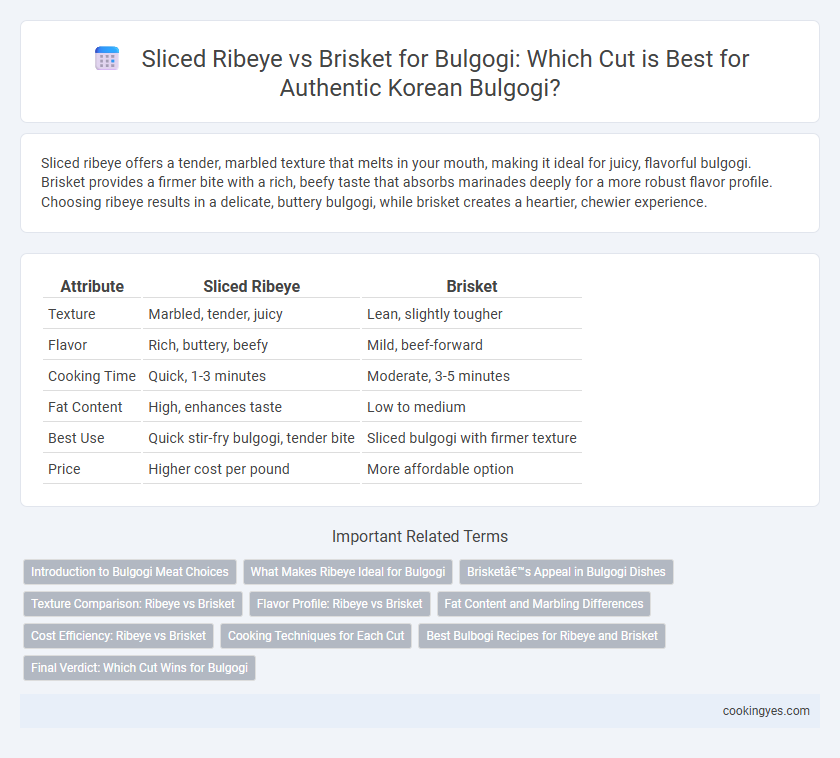Sliced ribeye offers a tender, marbled texture that melts in your mouth, making it ideal for juicy, flavorful bulgogi. Brisket provides a firmer bite with a rich, beefy taste that absorbs marinades deeply for a more robust flavor profile. Choosing ribeye results in a delicate, buttery bulgogi, while brisket creates a heartier, chewier experience.
Table of Comparison
| Attribute | Sliced Ribeye | Brisket |
|---|---|---|
| Texture | Marbled, tender, juicy | Lean, slightly tougher |
| Flavor | Rich, buttery, beefy | Mild, beef-forward |
| Cooking Time | Quick, 1-3 minutes | Moderate, 3-5 minutes |
| Fat Content | High, enhances taste | Low to medium |
| Best Use | Quick stir-fry bulgogi, tender bite | Sliced bulgogi with firmer texture |
| Price | Higher cost per pound | More affordable option |
Introduction to Bulgogi Meat Choices
Sliced ribeye and brisket are two popular meat choices for bulgogi, each offering distinct textures and flavors. Ribeye provides a rich, marbled tenderness that enhances the savory marinade absorption, while brisket delivers a leaner, slightly chewy bite with subtle beefy notes. Selecting between ribeye or brisket depends on personal preference for fattiness and tenderness in the traditional Korean bulgogi experience.
What Makes Ribeye Ideal for Bulgogi
Ribeye is ideal for bulgogi due to its marbling, which ensures tender, juicy bites that absorb the sweet and savory marinade effectively. The fat content in ribeye enhances flavor depth and prevents the meat from drying out during quick grilling. Unlike brisket, ribeye's finely textured meat breaks down evenly, delivering a consistently rich and tender bulgogi experience.
Brisket’s Appeal in Bulgogi Dishes
Brisket's rich marbling and robust beefy flavor make it a standout choice for bulgogi, offering a tender yet slightly chewy texture that soaks up the marinade deeply. Unlike the more uniformly tender ribeye, brisket's natural fat content melts during cooking, infusing each bite with intense savory and smoky notes. This cut enhances the traditional Korean bulgogi experience by adding a satisfying bite and complex flavor profile that complements the sweet and spicy marinade.
Texture Comparison: Ribeye vs Brisket
Sliced ribeye offers a tender, marbled texture that melts in the mouth, making it ideal for juicy, flavorful bulgogi. Brisket, with its leaner and slightly fibrous texture, provides a chewier bite but absorbs marinades deeply, enhancing the savory taste. The choice between ribeye and brisket impacts the bulgogi experience by balancing richness and tenderness against a more robust, textured chew.
Flavor Profile: Ribeye vs Brisket
Ribeye offers a rich, marbled texture that enhances Bulgogi with a buttery, savory flavor and juicy tenderness, making it ideal for a succulent bite. Brisket, leaner with a coarser grain, delivers a deeper, beefy taste that absorbs marinades well, resulting in a more robust, hearty flavor profile. Choosing ribeye emphasizes a melt-in-the-mouth experience, while brisket highlights bold, meaty notes, each shaping the Bulgogi's overall taste distinctively.
Fat Content and Marbling Differences
Sliced ribeye for bulgogi features higher fat content and abundant marbling, resulting in a tender, juicy texture and rich flavor that enhances the dish's savory profile. Brisket, while leaner with less intramuscular fat, offers a firmer bite and a more subtle, beefy taste that absorbs marinades effectively. Choosing ribeye emphasizes buttery richness, whereas brisket provides a balanced texture that highlights the marinated sweetness typical of bulgogi.
Cost Efficiency: Ribeye vs Brisket
Sliced brisket is generally more cost-efficient than ribeye for bulgogi, offering a tender texture with a lower price per pound, making it ideal for budget-conscious meals. Ribeye provides richer marbling and flavor but comes at a premium cost, which may impact large-batch preparations. Selecting brisket balances flavor and affordability, maximizing value without compromising the traditional taste of bulgogi.
Cooking Techniques for Each Cut
Sliced ribeye for bulgogi requires quick, high-heat cooking methods such as grilling or stir-frying to preserve its marbling and tenderness. Brisket, with its denser texture, benefits from marinating longer and cooking at a lower temperature or slow-cooking to break down connective tissues. These tailored techniques enhance the natural flavors and texture unique to each cut, optimizing the bulgogi experience.
Best Bulbogi Recipes for Ribeye and Brisket
Sliced ribeye offers rich marbling and tenderness that enhances the flavor and texture in the best bulgogi recipes, making it ideal for quick grilling or stir-frying with classic soy sauce, garlic, and sesame oil marinades. Brisket provides a leaner, slightly chewier bite that absorbs marinades deeply, creating a savory bulgogi experience best suited for slow cooking or grilling thinly sliced pieces to balance tenderness and flavor. Choosing between ribeye and brisket depends on desired texture and cooking method, with ribeye favored for its buttery softness and brisket for its robust, meatier essence.
Final Verdict: Which Cut Wins for Bulgogi
Sliced ribeye wins for bulgogi due to its rich marbling and tender texture, which enhances flavor and juiciness during the quick grilling process. Brisket, while leaner and slightly tougher, absorbs marinades well and offers a firmer bite, making it a budget-friendly alternative. For the perfect blend of tenderness and flavor, ribeye remains the top choice in authentic bulgogi preparation.
Sliced ribeye vs brisket for bulgogi Infographic

 cookingyes.com
cookingyes.com